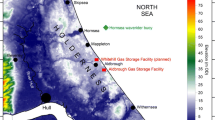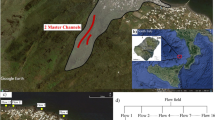Abstract
The Ganurgarh shale, a formation belonging to the Bhander Group of Vindhyan basin is investigated using field based detailed lithofacies and petrofacies analyses in order to interpret the depositional environment in a sequence stratigraphic context. Five major lithofacies have been recognized consisting of calcareous sandstones, laminated mudstones, rippled siltstones, red-grey shales and sandy limestones characterized by small to large-scale cross-bedding, ripple cross-lamination of wave and current origin, parallel lamination, low-angle horizontal bedding, flaser and lenticular bedding, mud-cracks, salt pseudomorphs, convolute bedding and load structures. The constituent lithofacies are recurring and grouped into three lithofacies associations where, the association A is composed of fining upwards and B with coarsening upwards cycles at the lower and middle levels of the succession respectively, are dominantly arenaceous whereas, the association C occurring at upper levels is fining upwards (FU) and becomes calcareous with meager representation of clastics. Petrographically, the section offers three main petrofacies viz., (a) sandstone- (b) siltstone- (c) sandy limestone-petrofacies. Lithofacies characters complimented with petrography show that deposition occurred within the shoreface (subtidal) to foreshore intertidal domain involving tidal flats with sub-environments ranging from intertidal to supratidal. However, lithofacies associations within the Ganurgarh shale of Maihar area represent a case of normal regression during sea level transgression. In the beginning, probably because of excessive sediment supply the sea level had a falling trend during an overall transgressive phase ultimately culminating into limestone sedimentation.
Similar content being viewed by others
References
Akhtar, K. and Srivastava, V. K. (1976) Ganurgarh Shale of southeastern Rajasthan, India: A precambrian regressive sequence of lagoon-tidal flat origin. Jour. Sed. Petrol., v.46(1), pp.14–21.
Alexander, C.R., Nittrour, C.A., Demaster, D.J., Park, Y.A. and Park, S.C. (1991) Macrotidal mudflats of the southwestern Korean coast: a model for the interpretation of intertidal deposits. Jour. Sedim. Res., v.61, pp.805–824.
Anderson, F.E. (1973) Observation of some sedimentary processes acting on a tidal flat. Mar. Geol., v.14, pp.101–116.
Auden, J.B. (1933) Vindhyan sedimentation in the Son Valley, Mirzapur district. Mem. Geol. Surv. India, v.62(2), pp.141–250.
Banerjee, I. (1964) On some broader aspects of Vindhyan sedimentation; Prod. 22nd International Geol. Cong. New Delhi, Part XV, pp.189–204.
Banerjee, S., Dutta, S., Paikaray, S. and Mann, U. (2006) Stratigraphy, Sedimentology and bulk organic geochemistry of black shales from the Proterozoic Vindhyan Supergroup (Central India). Jour. Earth System Sci., v.115(1), pp.37–47.
Basu, A., Young, S.W., Suttner, L. J., James, W.C. and Mack, G.H. (1975) Re-evaluation of the use of undulatory extinction and polycrystallinity in detrital quartz for provenance interpretation. Jour. Sediment. Petrol., v.45(4), pp.873–882.
Bhattacharyya, A., Chanda, S.K. and Bose, P.K. (1986) Upper Vindhyans of Maihar: A Field Guide; Published by Department of Geological Sciences Jadavpur Univ., Calcutta, pp.1–19.
Blatt, H. and Christie, J.M. (1963) Undulatory extinction in quartz of igneous and metamorphic rocks and its significance in provenance studies of sedimentary rocks. Jour. Sediment. Res., v.33(3), pp.559–579.
Blatt, H. (1967) Original characteristics of clastic quartz grains: Jour. Sediment. Petrology, v. 37, pp.401–424.
Bartholoma, A. and Flemming, B.W. (2007) Progressive grainsize sorting along an intertidal energy gradient. Sedimentary Geol., v.202, pp.464–472.
Bose, P. K. and Chaudhuri, A. (1990) Tide versus storm in epieric coastal deposition: two Proterozoic sequences India. Jour. Geol., v.25, pp.81–101.
Bose, P. K., Sarkar, S., Chakrabarty, S. and Banerjee, S. (2001) Overview of the meso- to neoproterozoic evolution of the Vindhyan basin, Central India. Sedimentary Geol., v.141–142, pp.395–419.
Catuneanu, O. (2002) Sequence stratigraphy of clastic systems: concepts, merits, and pitfalls. Jour. African Earth Sci., v.35, pp.1–43.
Chakraborti, A. (2005) Sedimentary structures of tidal flats: a journey from coast to inner estuarine region of eastern India. Jour. Earth System Sci., v.114, pp.353–368.
Chakraborty, P. P., Sarkar, S. and Bose, P.K. (1998) A viewpoint of Chenier Evolution: clue from a reappraisal of the Proterozoic Ganurgarh Shale, Central India. In: B.S. Paliwal (Ed.).The Indian Precambrian Scientific publishers Jodhpur, India, pp.61–72.
Crawford, A. R. and Compston, W. (1970) The age of the Vindhyan System of Peninsular India Quart. Jour. Geol. Soc. London, v.125, pp.251–371.
Dalrymple, R.W. (2010) Tidal Depositional Systems. In: N.P. James and R.W. Dalrymple (Eds.). Lithofacies Models, 4, GEOText6, Geol. Assoc., Canada, pp.199–208.
Davis, R.A. and Dalrymple, R.W. (Eds.) (2012) Principles of Tidal Sedimentology. Springer, New York, 621p.
De Raaf, J.F.M. and Boersma, J.R. (1971) Tidal deposits and their sedimentary structures: Geologie en Mijnbouw, v.50, pp.479–504.
Dickinson, W.R. (1985) Interpreting provenance relations from detrital modes of sandstones. In: G.G. Zuffa, (Ed.), Provenance of arenites. Reidel Publishing Co., Dordrecht, pp. 331–361.
Evans, G. (1965) Intertidal Flat sediments and their environment of deposition in the Wash. Jour. Geol. Soc. London. Quart. Jour., v.121, pp.209–245.
Ghazi, S. Andmountney, N. P. (2011) Petrography and provenance of the Early Permian Fluvial Warchha Sandstone, Salt Range, Pakistan. Sediment. Geol., v.233, pp.88–110.
Hird, K. and Tucker, M.E. (1988) Contrasting diagenesis of two Carboniferous oolites from South Wales: a tale of climatic influence. Sedimentology, v.35, pp.587–602.
Khalifa, M. and Morad, S. (2011) Impact of Structural Setting on Diagenesis of Fluvial and Tidal Sandstones: the Bahi Formation, Upper Cretaceous, NW Sirt Basin, North Central Libya. Marine and Petroleum Geology, doi: 10.1016/j.marpetgeo.2011.05.006.
Klein, G. Dev. (1963) Bay of Fundy intertidal zone sediments. Jour. Sed. Petrol., v.33, pp.844–854.
Kumar, S. (1976) Stromatolites from the Vindhyan rocks of Son Valley- Maihar area, districts Mirzapur (UP) and Satna (MP). Jour. Palaeont. Soc. India, v.18, pp.13–21.
Longhitano, S.G. (2011) The record of tidal cycles in mixed silicabioclastic deposits: examples from small Plio-Pleistocene peripheral basins of the microtidal central Mediterranean Sea. Sedimentology, v.58(3), pp.691–719.
Longhitano, S.G., Mellere, D., Steel, R.J. and Ainsworth, R. B. (2012) Tidal depositional systems in the rock record: A review and new insights. Sedimentary Geol., doi: 10.1016/j.sedgeo.2012.03.024.
Prasad, B. (1980) Vindhyan stromatolites stratigraphy in SE Rajasthan; Misc. Publ. Geol. Surv. India, v. 44, pp.201–206.
Prasad, B. and Ramasamy (1980) Stromatolites in Upper Vindhyans from Bundi, Kota, and Sawaimadhopur districts; Misc. Publ. Geol. Surv. India, v.44, pp.275–277.
Pettijohn, F. J., Potter P.E. and Siever, R. (1972) Sands and Sandstones. Springer-Verlag, New York, 618p.
Plint, A.G. Eyles, N. Eyles, C.H. and Walker, R.G. (1992) Control of sea level change. In: R.G. Walker and N.P. James (Eds.), Lithofacies Models-Response to Sea Level Change, Geol. Soc. Can., St. John’s, NF, pp.15–26.
Posamentier, H.G., Allen, G.P. and James, D.P. (1992) High resolution sequence stratigraphy- the East Coulee delta. Jour. Sed. Pet., v.62, pp.310–317.
Posamentier, H.G. and Allen, G.P. (1999) Siliciclastic sequence stratigraphy; concepts and applications. CONC. Sed. Paleo., v. 7, pp. 204.
Pratt, B.R., James, N.P. and Cowan, C.A. (1992) Peritidal carbonates. In: R.G. Walker, and N.P. James, (Eds.), Lithofacies Models: Response to Sea Level Change. Geological Association Canada, pp.303–322.
Ray, J. S., Veizer, J. and Davis, W. J. (2003) C, O, Sr and Pb isotope systematics of carbonate sequences of Vindhyan Supergroup India: age, diagenesis, correlations and implications for global events. Precambrian Res., v.121, pp.103–140.
Ray, J.S. (2006) Age of the Vindhyan Supergroup: a review of recent findings; Jour. Earth System Sci., v.115–1, pp.149–160.
Rao, K.S., Lal, C. and Ghosh, D.B. (1977) Algal stromatolites in Bhander Group Vindhyan Supergroup Satna district Madhya Pradesh. Rec. Geol. Surv. India, v.109(2), pp.38–47.
Reineck, H.E. (1967) Layered sediments of tidal flats, beaches, and shelf bottoms of the North Sea. In: G.H. Lauff, (Ed.), Estuaries: Washington, D.C., Am. Assoc. Adv. Sci. Pub. No. 83, pp. 191–206.
Reineck, H.E. (1972) Tidal Flats. In: J.K. Rigby and W.K. Hamblin (Eds.), Recognition of Ancient Sedimentary environments: SEPM Spec. Publ. No.16, pp.146–159.
Reineck, H.E. and Singh, I.B. (1967) Primary sedimentary structures in the recent sediments of the Jade, North Sea; Marine Geol., v.5, pp.227–235.
Renyaud, J.Y. and Dalrymple, R.W. (2012) Shallow-marine tidal deposits. In: S. Davis and R.W. Dalrymple (Eds.) Principles of Tidal Sedimentology, Springer, New York, pp.335–370.
Sarkar, B. (1974) Biogenic sedimentary structures and microfossils of the Bhander Limestone (Proterozoic) India; In: A. De (Ed.), Contributions to the earth and planetary sciences. Geol. Min. Met. Soc. India, Golden Jubilee Volume, pp.143–156.
Shukla, U.K. and Bachman, G.H. (2007) Estuarine sedimentation in the Stuttgart Formation (Carnian, Late Triassic), South Germany. N.Jb. Geol. Paläont. Abh., v.243(3), pp.305–323, Stuttgart.
Shukla, U.K. and Srivastava, R. (2008) Lizard eggs from Upper Cretaceous Lameta Formation of Jabalpur, central India, with interpretation of depositional environments of the nest-bearing horizon. Cretaceous Res., v.29, pp.674–686.
Singh, I.B. (1985) Palaeogeography of Vindhyan Basin and its relationship with other Late Proterozoic Basins of India. Jour. Palaeont. Soc. India, v.30, pp.35–41.
Tucker, M.E. and Bathurst, R.G.C. (1990) Meteoric Diagenesis. In: M.E. Tucker and R.G.C. Bathurst (Eds.), Carbonate Diagenesis. Spec. Publ. Internat. Assoc. Sedimentol., v 1, pp.181–183.
Valdiya, K.S. (1969) Stromatolites of Lesser Himalayan carbonate formation and the Vindhyan. Jour. Geol. Soc. India, v.10, pp.1–25.
Visher, M.J. (1980) Neap-spring cycles reflected in Holocene subtidal large-scale bedform deposits: A preliminary note. Geology, v.8, pp.543–546.
Walkden, G.M. and Berry, J.R. (1984) Syntaxial overgrowths in muddy crinoidal limestones: cathodoluminiscence sheds new light on an old problem. Sedimentology, v. 31, pp.251–267.
Author information
Authors and Affiliations
Corresponding author
Rights and permissions
About this article
Cite this article
Adnan, A., Shukla, U.K. A case of normal regression with sea level transgression: Example from the Ganurgarh shale, Vindhyan basin, Maihar area, M.P., India. J Geol Soc India 84, 406–416 (2014). https://doi.org/10.1007/s12594-014-0146-7
Received:
Revised:
Published:
Issue Date:
DOI: https://doi.org/10.1007/s12594-014-0146-7




